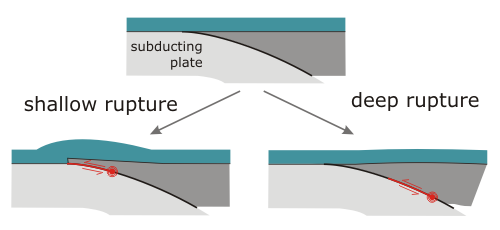There’s been another bout of seismic activity in Indonesia, with three earthquakes of magnitude 7 or greater, with the largest registering as an 8.4, and dozens of smaller quakes (many of which were still over magnitude 5.0), occurring since last Wednesday. The media coverage of these events prompted GrrlScientist (who keeps tabs on the goings on in her birds’ home region) to e-mail me a couple of excellent questions, which with her permission I’m answering publicly:
I heard this morning that the same area of Sumatra has been hit with three earthquakes within the past three days. What I want to know is: how do the scientists know these are three separate earthquakes instead of aftershocks of one quake? Is it because of the sheer size of each of these quakes? Also: are aftershocks always smaller than the initial earthquake?
To answer this it is necessary to first answer the question, what is an aftershock? An earthquake rarely occurs in isolation, because rupturing and displacement on one section of a fault will redistribute the stresses on adjacent sections, and even on other nearby faults, which may well trigger further earthquakes. So you often get days, weeks or even months of enhanced seismic activity – numerous earthquakes of various sizes – within a particular region. The biggest earthquake in such a sequence is referred to as the main shock; smaller earthquakes that precede it are referred to as foreshocks, and those which follow as aftershocks. By definition, a foreshock or aftershock is always smaller than the main shock.

So you can’t look at a particular earthquake on its own and label it as an aftershock; it is only within the context of the whole sequence that it is part of – if it occurs after the biggest earthquake in that sequence – that that label can be applied. Geography also needs to be considered: to count as aftershocks, the later earthquakes must be close enough to the initial rupture to make a direct influence likely. In the figure below, I’ve plotted the seismic activity between last Wednesday and Sunday, and it’s clear that all of the earthquakes – including the two later magnitude 7+ quakes – cluster in a particular region of the plate boundary.

1. Magnitude 8.4, 12 Sept 11:10 UTC, Depth 34 km.
2. Magnitude 7.9, 12 Sept 23:49 UTC, Depth 30 km.
3. Magnitude 7.0, 13 Sept 03:35 UTC, Depth 12 km.
Based on this, there is no real reason to view the two largest events after the main shock as ‘separate earthquakes’; they can quite reasonably be viewed as aftershocks of the initial magnitude 8.4. Nevertheless, as Grrl has commented, they do seem to have been singled out in the media, possibly because they are the ones that potentially represent a significant tsunami risk. Which leads on to the second question:
Why do some earthquakes that are underwater (or near the coast) generate tsunamis while others do not? Why do some quakes generate HUGE tsunamis while others generate only small waves, as one of these quakes apparently did?
The most important factor here is how deep the earthquake is beneath the Earth’s surface. To generate a substantial tsunami, an earthquake has to cause large (metre-scale) vertical movements of the sea-bed, which pushes around the ocean water above it. This requires that the rupture occurs at quite a shallow depth; although seismic waves can propagate around the world, the actual displacement associated with a large earthquake quickly decreases as you move away from its source. I’ve tried to illustrate this idea in the figure below, which shows movements of the sea-floor above a subduction boundary associated with a shallow rupture (marked in red in the lower left figure) and a deeper rupture (lower right figure). In both cases, the ruptures are of about the same length, so their maximum displacements, and the size of the earthquake they generate, are also about the same. However, their different depths result in substantially different effects on the ocean floor. The shallow rupture propagates all the way to the surface, displacing the sea bottom by a large amount and generating a tsunami; in contrast, the greater distance between the deeper rupture and the surface results in much smaller ocean floor displacement, generating no, or a very small, tsunami.

The three magnitude 7+ earthquakes last week were caused by ruptures at a depths of 38, 30 and 12 km respectively, the Boxing Day 2004 earthquake was located at a depth of 7 km. Fortunately, therefore, the recent large earthquakes occurred at too great a depth on the subduction boundary to cause very large displacements at the surface.
Hopefully this helps to clear up the issues raised by Grrls’ questions. I’ll also take this opportunity to encourage anyone with geological questions to comment somewhere or e-mail me – I may not always use them as the basis for a post, but I will always try to answer them.



Comments (11)